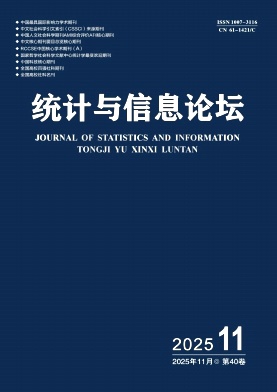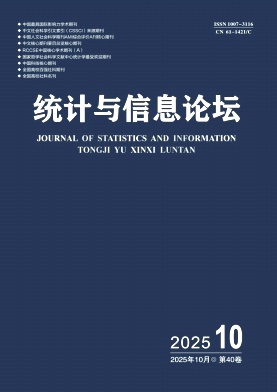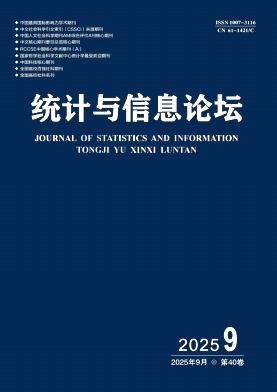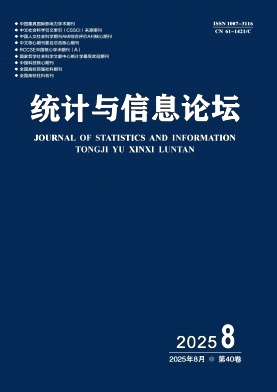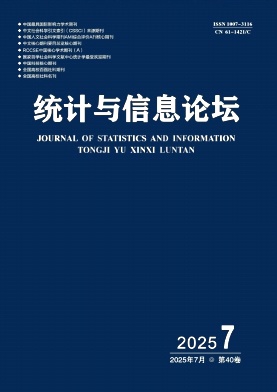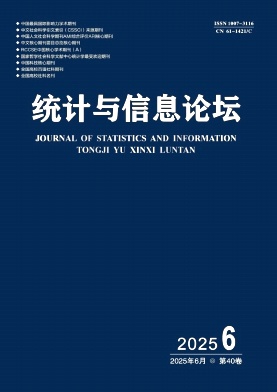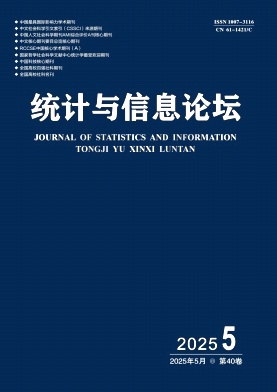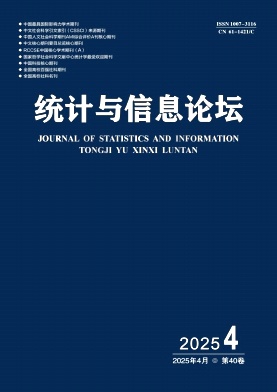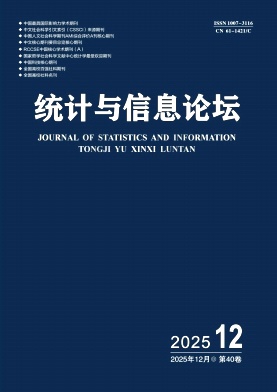
Information
Sponsor: Shaanxi Provincial Department of Education
Sponsored by:Xi'an University of Finance and Economics
Higher Education Branch of China Statistical Education Society
Director: ZHAO MINJUAN
Vice Director: LI JIAORUI ZHAO YANYUN
Publisher: Editorial Department of Journal of Statistics and Information
Address:No. 64, XiaozhaiEast Road, Yanta District, Xi’an, China
Post Code:710061
E-mail: tjyxxlt@126.com
WeChat Official

Research on the Framework Design and Compilation of Satellite Accounts for Data Assets
WANG Panpan;JIA Xiaoai;With the development of the digital economy, data assets have garnered increasing attention from both national governments and enterprises.A critical challenge in data asset accounting lies in rigorously and systematically quantifying the pivotal role that data assets play in driving the national economy.By constructing satellite account for data assets, it becomes possible to systematically quantify data-driven economic activities and dynamically assess the value of data assets.Grounded in the interconnected structure of data assets within economic operations, this framework adpts a multi-dimensional, hierarchical account system that comprehensively maps the lifecycle and economic contributions of data assets.The accounting entities in the data asset satellite accounts are classified into two dimensions based on the production and utilization of data assets, corresponding to industrial sectors and institutional sectors, respectively.The accounting objects include data products and data assets.Data products are further categorized into eight distinct types based on variations in their supply mechanisms and usage patterns, thereby facilitating the exploration of tailored valuation methodologies for different types of data products.A holistic accounting framework for data assets must systematically address two interconnected dimensions: the endogenous processes governing the creation and accumulation of data assets themselves, and the exogenous spillover effects through which these assets influence broader economic indicators.To operationalize this dual perspective, dedicated endogenous accounts and exogenous accounts and are established as complementary components of the accounting system.The endogenous accounts adhere to the principles of double-entry bookkeeping and national economic equilibrium(where total output, total income, and total expenditure are equal),and are structured in alignment with the core sequence of national economic accounts.Starting with the production account, the framework progresses through flow-based accounts such as income distribution and capital formation.These sequential analyses culminate in stock accounting to evaluate the accumulated value of data assets.This systematic approach enables the compilation of flow accounts(including the goods and services account, production account, distribution of income account, and capital account) alongside dedicated the data asset stock accounts, thereby capturing both transactional dynamics and cumulative asset valuation within a unified system.The exogenous accounts for data assets take Gross Domestic Product(GDP) as an example, GDP impact accounts are established under distinct GDP accounting methodologies(production, income, and expenditure approaches) to systematically quantify how data capitalization redefines GDP measurement.By extracting and applying relevant data from input-output tables to conduct an empirical case implementation of the accounts, this research validates the operational feasibility and structural coherence of the Data Asset Satellite Account framework, demonstrating its alignment with established economic measurement standards.
Sequential Merging of Multi-source Income Data and Remeasurement of Inequality
RUAN Jing;LIU Ruiqi;This paper proposes a novel approach to measuring income inequality in China by constructing a multi-source income dataset that more effectively captures the full spectrum of income distribution, particularly the upper tail.A key methodological innovation lies in the sequential merging of contemporaneous income data from three distinct data sources—household surveys, executive compensation records, and billionaire wealth rankings—enabling the endogenous identification of merging thresholds between these data sources.This strategy addresses the long-standing underrepresentation of high-income individuals in household survey data and enhances the accuracy and comprehensiveness of income inequality measurement.The merging procedure identifies two internal thresholds using representative ratios and their cumulative counterparts.These thresholds determine the income levels at which the original household data are systematically reweighted to account for high-income individuals.Specifically, household income data are drawn from two major nationally representative surveys: the China Family Panel Studies(CFPS 2016—2020) and the Chinese General Social Survey(CGSS 2015—2021),which reliably capture income patterns of low-and middle-income groups.For the high-income group, income data of listed company executives is used.For the ultra-high-income group, income data from the Hurun Rich List is adopted.Empirical results show that in 2015,the first merging point—between survey data and executive compensation data—corresponded to the 81st income percentile(RMB 62 500),rising to RMB 111 200 in 2021.The second merging point—between executive compensation and billionaire income—corresponded to the 91st percentile(RMB 1.21 million) in 2015 and RMB 1.41 million in 2021.Lorenz curves are employed to visualize income distribution before and after data integration.After correction, the upper tail of the distribution shows a noticeable “bulge”,suggesting a higher and more accurate income concentration among top earners.This pattern holds across years, underscoring the systematic underestimation of inequality in raw household survey data.These indicate that high-income undercoverage in surveys persists and intensifies over time.To evaluate the effect of the merging procedure, the paper adopts an Expectation-Maximization(EM) algorithm to estimate a flexible mixture distribution that combines three components: normal—normal—Pareto.Among several candidate models, this combination yields the best fit, as it minimizes the distribution error ratio—a metric used to evaluate the goodness-of-fit between empirical and estimated income distributions.The endogenous merging approach outperforms the exogenous one in capturing the multi-source data's distributional properties, offering a stronger empirical foundation for future studies.Further, the merged dataset not only recovers a more realistic income distribution but also supports more accurate estimation of inequality metrics such as the K coefficient and top income shares.In summary, this paper offers a data-enhanced and methodologically rigorous approach to better understanding income inequality in China.By sequential merging diverse income data sources through a theoretically grounded and statistically validated process, the study provides a valuable tool for policymakers seeking to monitor and adjust excessively high incomes in pursuit of common prosperity.
The Impact of New Quality Productive Forces on Urban Economic Resilience
WANG Jiating;LI Wenxuan;In the current critical period of promoting productivity transformation and advancing Chinese-style modernization, achieving the dual objectives of sustaining robust urban economic growth and enhancing urban economic resilience is of paramount strategic importance.Maintaining this balance is crucial for effectively preventing and mitigating major economic risks and realizing truly high-quality urban development.The research systematically examines the theoretical connotations and core elements of new quality productive forces, and constructing a comprehensive multi-dimensional indicator system to measure their development levels among 275 prefecture-level and above cities in China from 2011 to 2022.Based on this framework, the study employs econometric methods with the bidirectional fixed effects model and the threshold regression model to empirically investigate the precise impact of new quality productive forces on the urban economic resilience, providing valuable insights for policy formulation.The results show that:(1) The cultivation and development of new quality productive forces demonstrates a statistically significant positive effect on enhancing urban economic resilience.This fundamental relationship remains robust after passing a series of robustness tests.(2) The study identifies three primary transmission mechanisms: the modernization and upgrading of the industrial structure, the activation and stimulation of enterprise entrepreneurship, and the intelligence transformation of enterprise innovation processes.New quality productive forces fundamentally drive industrial transformation towards more advanced, efficient, and synergistic forms, reducing structural rigidities and creating more adaptive economic systems.They simultaneously stimulate entrepreneurial vitality within enterprises, fostering organizational adaptability, strategic innovation, and risk-taking capabilities essential for withstanding economic fluctuations.Furthermore, they promote the deep integration of intelligent technologies such as artificial intelligence and big data analytics into the innovation process, substantially increasing the innovation process' s efficiency, precision, and responsiveness to market changes.(3) The impact exhibits significant heterogeneity across different urban contexts.The promoting effect is substantially more pronounced in non-resource-based cities.Moreover, It is stronger in smaller-scale cities.Additionally, cities with pre-existing strong innovation capabilities benefit more significantly.This heterogeneity suggests the need for region-specific policy approaches.(4) After introducing the threshold variable of urban economic development level, it is found that the impact effect of new quality productive forces on urban economic resilience exhibits a nonlinear upword trend.A lower economic development level is not conducive to the positive role of new quality productive forces.When the urban economic development level rises to a certain extent, it can enhance the city's ability to cultivate and absorb new quality productive forces.This will significantly enhance the economic resilience of the city.Therefore, urban development policies should shift towards fostering and developing new quality productive forces, including gradually establishing a long-term mechanism for preventing urban economic risks, guiding the transformation and upgrading of the industrial structure, enhancing the entrepreneurial vitality of enterprises, and promoting the research and development of intelligent technologies.In addition, it is necessary to integrate the economic development foundation and in a contert-specific manner level of different cities, comprehensively apply policy tools, and give full play to the incentive effect of new quality productive forces on urban economic resilience.The research conclusion not only provides a new perspective for effectively promoting high-quality urban development, but also offers policy inspirations for enhancing urban economic resilience and strengthening cities' capacity to prevent and defuse major risks during the 15th Five-Year Plan period.
Study on the Impact of Health Resources on High-quality Population Development
TAO Chunhai;CHEN Qijin;TAO Ruoyan;Health resources play a fundamental role in supporting urban development.They are not only closely tied to personal health and quality of life, but also exert a profound and lasting impact on regional economic development and social stability.In the context of China's ongoing demographic transition and accelerating population aging, optimizing the allocation and efficient utilization of health resources is of great significance to promoting high-quality population development and effectively narrowing regional disparities.This study aims to explore the impact and spatial effects of health resource allocation on the level of high-quality population development across China's provinces.Based on panel data of Chinese provinces spanning 2013 to 2022,this study constructed an evaluation index system for high-quality population development is constructed from five dimensions: population size, population quality, population structure, population distribution, and population foundation.The comprehensive index is calculated using the entropy weight method.Furthermore, kernel density estimation is emprogeon to explore the spatial distribution and temporal trends changes of high-quality population development and health resources, providing insights into regional development dynamics and structural shifts.At the same time, in order to empirically assess both the direct and spatial spillover effects of health resources allocation on high-quality population development, the spatial Durbin model is employed to analyze spatial interactions among provinces.Furthermore, a threshold effect model is adopted to explore the potential nonlinear influence of Internet penetration on this relationship, thereby revealing how digital infrastructure moderates the impact of health resource allocation.The empirical results show that: First, health resources exert a significant positive effect on promoting high-quality population development.Moreover, there is a notable spatial spillover effect, indicating that health resources in one province can positively influence neighboring regions.However, this effect weakens with increasing geographical distance.Specifically, the spatial spillover effect begins to weaken beyond 600 kilometers and exhibits a characteristic of first promoting then inhibiting within 900 kilometers.Second, heterogeneity analysis reveals that in regions with underdeveloped Internet and lagging urbanization, the level of high-quality population development in a province is significantly affected by the spatial spillover effect of health resources in neighboring provinces, and the indirect role of health resources in promoting high-quality population development is more obvious.Third, the study finds that with the popularization of the Internet, the impact of health resources on the high-quality development of the population showed obvious nonlinear characteristics.This shows that under different levels of Internet development, the intensity and mechanism of health resources vary, and the Internet plays a threshold role.This study not only provides a scientific basis for various regions to formulate and optimize population-related policies, but also provides data support and empirical reference for improving the efficiency of health resource allocation and enhancing overall resource integration capacity.In addition, the research results have important policy value and practical significance for promoting high-quality population development in China and narrowing regional development gaps, thereby providing strong support for advancing China's modernization process.
Dynamic Evaluation of Monetary Policy Implementation Intensity and Optimization of Policy Efficiency
LIU Huihao;ZHANG Weiqi;The pace and intensity of monetary policy operations are closely tied to the stability of the macroeconomy, making the optimization of monetary policy effectiveness a critical topic for both academia and practice.In particular, China's unique economic structure has made the fine-tuning of monetary policy a complex but essential task.While existing research primarily focuses on the transmission mechanisms of China's monetary policy, there is a lack of studies constructing evalvation models for policy optimization paths.This paper first derives a comprehensive dynamic evaluation framework for the optimization of monetary policy, based on which it quantifies the effects and optimization potential of monetary policy at different points in time.The findings of this study are as follows: First, from the first quarter of 2008 to the fourth quarter of 2022,both quantity-based and price-based monetary policies in China exerted positive effects on economic growth and price stability, though with heterogeneous impacts.Second, the dynamic trend of the optimal policy adjustment coefficient indicates that China's monetary policy has consistently operated within a reasonable range.With the exception of a few specific time points where further improvements could be made, the central bank's monetary policy actions have generally been appropriate and moderate.Third, using the proposed evaluation framework, the study identifies four representative time points with potential policy optimization space to conduct counterfactual scenario analysis.A comparison shows that in the first quarter of 2010,optimized quantity-based and price-based policies exerted better effects on economic growth and price stability.In the first quarter of 2012,adjusted quantity-based and price-based policies demonstrated significantly more effective short-and long-term effects in addressing the inflation gap compared to the welfare losses arising from the output gap deviation.In the second quarter of 2015,if the central bank had adoped a more flexible combination of quantity-based and price-based policies, with short-term adjustments to the former and long-term flexibility in the latter, the policy objectives could have been achieved at a lower cost.In the second quarter of 2020,the targeted adjustment effectiveness of quantity-based and price-based tools showed short-term advantages, suggesting that the central bank needed to balance its immediate goals with long-term objectives and select the most appropriate optimized policy.The study reveals that, under different economic cycles and policy transition contexts, optimized quantity-based and price-based monetary policy tools can enhance policy effectiveness and reduce implementation costs in their respective economic environments.In particular, during periods of economic transition or uncertainty, the flexibility to adjust policy tools in a timely manner is crucial for minimizing welfare losses and ensuring macroeconomic stability.In conclusion, the policy implications of this study suggest that monetary authorities should be adept at selecting the appropriate mix of quantity-based and price-based tools based on current economic conditions and policy goals.Ensuring that monetary conditions align with the potential growth rate and maintaining price stability are essential for fostering long-term economic health.
Research on the Spatiotemporal Evolution and Development Obstacles of New Quality Productive forces's Ecological Environment
XU Hao;FENG Tao;Accelerating the cultivation of new quality productivity is the key to China 's current economic transformation and upgrading,and optimizing the ecological environment for the development of new quality productive forces is the prerequisite for accelerating the cultivation of new quality productive forces.Firstly,based on the connotation of the Marxist concept of productive forces,this paper analyzes the ecological environment factors of the development of new quality productive forces from the perspective of innovation value chain.Then,an evaluation index system for the ecological environment of new quality productive forces is constructed from five dimensions:organizational competition,factor input,development output,market environment and policy incentives.Using data from 30 mainland provinces in China from2013 to 2022 as samples,entropy weight method,spatial Moran index,and obstacle degree model are used for analysis.The results show that the overall ecological environment level of China ' s new quality productive forces is on the rise,with the eastern region significantly better than the central and western regions,and the northeast region deteriorating year by year;In 2022,Guangdong,Jiangsu,and Zhejiang ranked among the top three,while Qinghai had the fastest development with an average annual growth rate of 4.496 %;The eight major economic zones have significant differences,showing a trend of relative convergence and absolute divergence,with the Northwest Economic Zone optimizing the fastest;The south is significantly better than the north,showing a relative and absolute dual trend of development between the north and the south;There is significant spatial agglomeration in the ecological environment of inter provincial new quality productive forces,with spatial agglomeration characteristics transitioning in provinces and cities such as Beijing,Hunan,and Jiangxi.The main obstacles to optimizing the ecological environment of new quality productive forces have shifted from insufficient infrastructure in 2013 to insufficient talent investment in 2022.Talent investment has become the main obstacle to the development of the eastern,central,and western regions,while the administrative environment is the main obstacle to the development of the Northeastern region.There are significant differences in regional and inter provincial obstacles,which need to be overcome according to local conditions.Finally,it is recommended to optimize the ecological environment according to local conditions by optimizing the talent ecology,improving the policy ecology,and enhancing the market ecology,in order to accelerate the formation of new quality productive forces.
[Downloads: 544 ] [Citations: 0 ] [Reads: 0 ] HTML PDF Cite this article
Enterprise Digital Transformation,Supply Chain Spillover Effect and Employment Stabilization
HU Lei;WU Qiang;JIANG Zhener;Employment is the foundation of peoples livelihood,which bears on social stability and economic development.In the context of the booming development of the digital economy,digital transformation has not only emerged as a key path for enterprises to enhance competitiveness, but also has a profound impact on the job market.By improving production efficiency and expanding market size,digital transformation of enterprises can enhance their capacity to absorb employment.As collaboration within industrial and supply chains continues to gain importance,enterprises along the chain establish financial and business connections through their input-output relationships.Consequently,decisions made by one enterprise are transmitted to others along the chain, giving rise to supply chain spillover effects.Therefore,it is worth exploring whether the employment effects of digital transformation of enterprises can spill over along the supply chain.Using data from Chinese A-share listed companies from 2009 to 2022,this study empirically examines the impact and mechanism of digital transformation of suppliers on the labor employment scale client firms.It is found that digital transformation of suppliers significantly expands the scale of employment in clients.Mechanism tests indicate three primary channels:improving clients ' financial conditions,enlarging clients ' production scale,and enhancing clients ' market competitiveness.Heterogeneity analyses reveal notable differences across contexts.The employment expansion effect weakens when clients firms have higher levels routine task intensity or greater overstaffing,but is more pronounced among labor-intensive clients.The spillover is stronger when suppliers and clients operate in different industries or regions,and when clients are state-owned,high-growth,or high-productivity firms.The effect is also more prominent for clients located in regions with higher labor-market integration or those in Eastern China.The conclusion of this study provides a theoretical basis and empirical evidence to clarify the impact mechanism of supplier's digital transformation on the labor employment scale of clients.In light of this,four policy suggestions are proposed:accelerate the promotion of enterprises digital transformation, play the “multiplier" role of employment;strengthen the linkage effect of industrial and supply chains, improve the modernization level of industrial and supply chains;play the employment creation effect of digital transformation,prevent and resolve the impact of employment substitution;formulate differentiated support policies,and promote the effective linkage between digital transformation and stable employment.These suggestions provide important policy implications for promoting the deep integration of the real economy and digital economy,enhancing the modernization level of industrial and supply chains,and stabilizing and expanding employment scale.
[Downloads: 1,104 ] [Citations: 0 ] [Reads: 0 ] HTML PDF Cite this article
Digital Infrastructure Construction and Coordinated Development of Urban "Carbon Reduction,Pollution Reduction,Green Expansion and Growth"
XIN Chongchong;LUO Yangfan;ZHONG Shunbin;Accelerating the construction of digital infrastructure is an important foundation for realizing the coordinated development of the urban "carbon reduction,pollution reduction,green expansion and growth".On the basis of theoretical explanation of the coordinated development of urban digital infrastructure construction in promoting urban "carbon reduction,pollution reduction,green expansion and growth",using the panel data of 282 cities at or above the prefecture level from 2006 to 2021,and based on the quasi-nature of "Broadband China" strategic demonstration city,this paper empirically investigates the role of digital infrastructure construction in promoting urban "carbon reduction, pollution reduction, green expansion and growth" by using DID method.The research finds that:firstly, the construction of urban digital infrastructure is helpful to promote the coordinated development of "reducing carbon,reducing pollution,green expansion and growth",and this conclusion still holds after a series of robustness tests and discussions on endogenous issues.Second,the construction of digital infrastructure has a stronger role in promoting the coordinated development of "carbon reduction,pollution reduction,green expansion and growth" in the eastern region,cities with high degree of cooperation,cities with good economic conditions and cities with high Internet level.Third,digital infrastructure construction promotes the coordinated development of "reducing carbon, reducing pollution, green expansion and growth" by promoting green technology innovation, strengthening environmental regulation and increasing government environmental protection expenditure.In this regard, it is suggested to continue to strengthen the construction of urban digital infrastructure and promote the development of digital economy;Adopt differentiated measures to advance the development of the digital economy in light of conditions;Enhance the breadth and depth of urban digital application,so that it can effectively promote the coordinated development of "carbon reduction,pollution reduction,green expansion and growth" in cities for a long time.
[Downloads: 1,053 ] [Citations: 0 ] [Reads: 0 ] HTML PDF Cite this article
Research on the Impact of National Logistics Hubs Construction on Enterprise Innovation Performance
LUO Jian;ZHENG Yanqi;At the current historical juncture,which embodies a new developmental phase characterized by the strategic convergence and synergistic alignment between the national logistics hub construction initiative and the innovation-driven development strategy,it is imperative for enterprises to engage in a profound and comprehensive integration of the advancement of national logistics infrastructure with the enhancement of their own innovation performance.This deep integration is critically necessary to establish a solid and enduring foundation that will underpin and facilitate the achievement of high-quality economic development, ensuring sustained growth,structural optimization, and long-term competitiveness within the economic framework.Leveraging a comprehensive panel dataset comprising A-share listed companies in China from the period 2013 to 2022,this study conceptualizes the rollout of the National Logistics Hub initiative as a " quasi-natural experiment." This methodological approach allows for the application of a Difference-in-Differences(DID) model,to systematically identify and evaluate the causal effect of this specific policy intervention on corporate innovation performance,while also probing into the underlying transmission channels through which this effect is materialized.The empirical results demonstrate that the construction of national logistics hubs exerts a promotive effect on corporate innovation performance.This fundamental conclusion remains statistically robust and substantiated following rigorous methodological examinations, including parallel trend tests placebo tests, and an extensive series of robustness checks addressing potential confounding factors and alternative model specifications, thereby reinforcing of the causal inference regarding the policy ' s efficacy in enhancing firms ' innovative outcomes.Further empirical investigation demonstrates that the pilot policy effectively facilitates the enhancement of corporate innovation performance by systematically expediting enterprises ' digital transformation.Heterogeneity analysis reveals that the policy effects exhibit statistically significant variations attributable to disparities in firms ' technological attributes and regional resource endowments.Specifically,non-high-technology enterprises experience a more substantial augmentation in innovation performance relative to hightechnology enterprises as a direct consequence of the logistics hub construction initiatives,indicating a disproportionately greater innovation-promoting effect for the former.Concurrently,from the regional characteristic perspective,enterprises situated in geographical areas characterized by relatively underdeveloped logistics infrastructure demonstrate a markedly heightened degree of policy responsivenes.The research findings systematically and comprehensively elucidate the intrinsic mechanisms through which the construction of national logistics hubs exerts a formative influence on corporate innovation performance,thereby providing robust empirical substantiation for deciphering the causal relationships between national policy initiatives and firms' innovation outcomes.Concurrently,the study yields granular empirical references and strategically significant policy insights from a micro-level perspective, which facilitate the targeted alignment of the national logistics hub strategy with enterprises characterized by heterogeneous attributes and contribute to the optimization of regional policy layouts.This investigation consequently embodies considerable theoretical import and possesses profound practical ramifications,enhancing both academic understanding and evidence-based policy formulation in the interrelated domains of infrastructure development and innovation-driven economic growth.
[Downloads: 652 ] [Citations: 0 ] [Reads: 0 ] HTML PDF Cite this article
Configuration Analysis of Government's Digital Service Capacity Synergistic with the Development of New Quality Productive Forces
LI Yanling;CAI Xiangjie;Enhancing government digital service capacity is crucial for modernizing the national governance system and is closely aligned with the initiative to "develop new quality productive forces based on local conditions" outlined in the 2025 Government Work Report.Although notable progress has been made in the digital transformation of governments across China,significant regional disparities persist,alongside challenges such as insufficient infrastructure and ongoing organizational restructuring.Therefore,further investigation is needed into how to strengthen digital service capacity to synergistically promote new quality productive forces.Based on panel data from 30 Chinese provinces(2015—2023) and guided by the Technology-Organization-Environment(TOE) framework,this study constructs a configurational model incorporating seven factors—including digital infrastructure,government organizational openness,and intergovernmental competition—that collectively shape digital service capacity.Using Qualitative Comparative Analysis(QCA),the study identifies multiple pathways through which these factors jointly enhance capacity.Regression analysis is further applied to examine how these pathways drive regional new quality productive forces.The findings reveal that no single factor is sufficient to generate high-level digital service capacity;instead,it arises from the interaction of multiple conditions,with government organizational openness playing a particularly critical role.Six distinct pathways are identified,including:a synergistic symbiosis type lightly promoted by government finance and digital technology application;a similar type driven by government finance and education;an organization-guided type facilitated by digital technology application;an environment-guided type supported by government finance;a diversified composite-guided type promoted by government finance in contexts of not-high civic literacy;and an environment-guided type driven by civic literacy in settings with not-high digital technology application.Five of these pathways enhance both digital service capacity and new quality productive forces by unleashing labor productivity,reshaping production relations,and enabling innovative allocation of production factors.Credit marketization exhibits a positive moderating effect in four of the pathways,though it shows no significant effect in the two environment-guided types.This study provides theoretical and empirical insights into the complex formation mechanisms of digital service capacity and its synergistic relationship with new quality productive forces,offering important policy implications for advancing governance modernization.
[Downloads: 1,281 ] [Citations: 0 ] [Reads: 0 ] HTML PDF Cite this article
A Review of Technologies on Random Forests
FANG Kuang-nana,b,WU Jian-bina,ZHU Jian-pinga,b,SHIA Bang-changa,b(a.Department of Statistics,School of Economics;b.Data Mining Center,Xiamen University,Xiamen 361005,China)Random Forests is a statistical learning theory,using bootsrap re-sampling method form sample sets,and then combining the tree predictors by majority voting so that each tree is grown using a new bootstrap training set.It is widely applied in medicine,bioinformatics,economics and other fields,because of its high prediction accuracy,good tolerance of noisy data,and the law of large numbers they do not overfit.In this paper we first introduce the concept of random forest and the latest research,then provide some important aspects of applications in economics,and a summary is given in the final section.
[Downloads: 39,911 ] [Citations: 1,960 ] [Reads: 75 ] HTML PDF Cite this article
Analysis on the Reliability and Validity of Questionnaire
ZENG Wu-yi~1,HUANG Bing-yi~2(1.School of Economics,Xiamen University,Xiamen 361005,Fujian;2.School of Management,Xiamen University,Xiamen 361005,Fujian)Study on the reliability and validity of the questionnaire has always been neglected in many(questionnaire) surveys in China.This paper mainly investigates the reliability and validity of a questionnaire and their evaluating methods.It also simply introduces how to use SPSS software to analyze the reliability and(validity) of a questionnaire.
ESG Performance,Institutional Investor Preference and Firm Value of Listed Companies
BAI Xiong;ZHU Yi-fan;HAN Jin-mian;To explore whether the ESG practices of listed companies can create value for the company and whether institutional investors in the capital market have ESG investment preferences will help companies recognize, participate in and practice the concept of ESG sustainable development.Based on the data of 3 400 A-share listed companies in Shanghai and Shenzhen Stock Exchange from 2013 to 2020,the shareholding ratio of institutional investors is introduced to explore the mechanism of ESG performance affecting corporate value and analyze whether institutional investors have ESG investment preference on this basis.The results are as follows:(1) ESG has the function of value creation.Good ESG performance of listed companies can significantly enhance their corporate value.(2) Attracting institutional investors to increase their shares is one of the ways for listed companies to enhance corporate value through ESG practice, and the proportion of institutional investors plays a partial intermediary role in the process of ESG influencing corporate value.(3) Institutional investors have a preference for ESG investment, and to a certain extent, they can tolerate low short-term operating performance of listed companies with good ESG performance All the above conclusions are robust.In the extended study, it is found that there is no heterogeneity in the value creation function of ESG between state-owned and non-state-owned listed companies.The preference of institutional investors ESG has heterogeneity in property rights and industry.Institutional investors prefer the listed companies with good performance of ESG in the secondary and tertiary industries and non-state-owned enterprises.Based on the research conclusions, suggestions are puts forward to accelerating the top-level design of ESG information disclosure and regulatory standards, encouraging companies to strengthen information disclosure, and cultivating medium and long-term institutional investors, which will help build and improve China's ESG development ecosystem and promote high-quality development.
[Downloads: 22,327 ] [Citations: 584 ] [Reads: 52 ] HTML PDF Cite this article
A Summary of Machine Learning and Related Algorithms
CHEN Kai1,ZHU Yu1,2(1.School of Statistics,Renmin University of China,Beijing 100872,China;2.Xi'an University of Finance & Economic,Xi'an 710061,China)Since the computer was invented,people have been wanted to know that whether it can learn.Machine learning is essentially a multidisciplinary field. It absorbed some results of artificial intelligence,probability and statistics,computational complexity theory,control theory,information theory,philosophy,physiology,neurobiological.This paper mainly based on statistical learning wanted to give a brief review and presentation to the perspective of machine learning and the development of related algorithms.
[Downloads: 25,942 ] [Citations: 542 ] [Reads: 76 ] HTML PDF Cite this article
A Review of Technologies on Quantile Regression
CHEN Jian-bao,DING Jun-jun(Macroeconomics Research Center,Xiamen University,Xiamen 361005,Fujian)Ordinary least square(OLS) regression models the relationship between vector of covariate and the conditional mean of a responsegiven.However,quantile regression models the relationship between covariateand the conditional quantiles of given.Taken together the ensemble of estimated conditional quantile offers a much more complete view of the effect of covariates on the location,scale and shape of the distribution of the response variable.It is especially useful in applications where people are interested in upper or lower quantiles of a response.In this paper we first introduce the concept of quantile regression,then provide some brief methods about estimation,hypothesis tests and goodness-of-fit of quantile regression,some important aspects of applications in economics are reviewed,a summary is given in the final section.
[Downloads: 9,970 ] [Citations: 409 ] [Reads: 85 ] HTML PDF Cite this article
A Review of Technologies on Random Forests
FANG Kuang-nana,b,WU Jian-bina,ZHU Jian-pinga,b,SHIA Bang-changa,b(a.Department of Statistics,School of Economics;b.Data Mining Center,Xiamen University,Xiamen 361005,China)Random Forests is a statistical learning theory,using bootsrap re-sampling method form sample sets,and then combining the tree predictors by majority voting so that each tree is grown using a new bootstrap training set.It is widely applied in medicine,bioinformatics,economics and other fields,because of its high prediction accuracy,good tolerance of noisy data,and the law of large numbers they do not overfit.In this paper we first introduce the concept of random forest and the latest research,then provide some important aspects of applications in economics,and a summary is given in the final section.
[Downloads: 39,911 ] [Citations: 1,960 ] [Reads: 75 ] HTML PDF Cite this article
A Summary of Machine Learning and Related Algorithms
CHEN Kai1,ZHU Yu1,2(1.School of Statistics,Renmin University of China,Beijing 100872,China;2.Xi'an University of Finance & Economic,Xi'an 710061,China)Since the computer was invented,people have been wanted to know that whether it can learn.Machine learning is essentially a multidisciplinary field. It absorbed some results of artificial intelligence,probability and statistics,computational complexity theory,control theory,information theory,philosophy,physiology,neurobiological.This paper mainly based on statistical learning wanted to give a brief review and presentation to the perspective of machine learning and the development of related algorithms.
[Downloads: 25,942 ] [Citations: 542 ] [Reads: 76 ] HTML PDF Cite this article
Analysis on the Reliability and Validity of Questionnaire
ZENG Wu-yi~1,HUANG Bing-yi~2(1.School of Economics,Xiamen University,Xiamen 361005,Fujian;2.School of Management,Xiamen University,Xiamen 361005,Fujian)Study on the reliability and validity of the questionnaire has always been neglected in many(questionnaire) surveys in China.This paper mainly investigates the reliability and validity of a questionnaire and their evaluating methods.It also simply introduces how to use SPSS software to analyze the reliability and(validity) of a questionnaire.
ESG Performance,Institutional Investor Preference and Firm Value of Listed Companies
BAI Xiong;ZHU Yi-fan;HAN Jin-mian;To explore whether the ESG practices of listed companies can create value for the company and whether institutional investors in the capital market have ESG investment preferences will help companies recognize, participate in and practice the concept of ESG sustainable development.Based on the data of 3 400 A-share listed companies in Shanghai and Shenzhen Stock Exchange from 2013 to 2020,the shareholding ratio of institutional investors is introduced to explore the mechanism of ESG performance affecting corporate value and analyze whether institutional investors have ESG investment preference on this basis.The results are as follows:(1) ESG has the function of value creation.Good ESG performance of listed companies can significantly enhance their corporate value.(2) Attracting institutional investors to increase their shares is one of the ways for listed companies to enhance corporate value through ESG practice, and the proportion of institutional investors plays a partial intermediary role in the process of ESG influencing corporate value.(3) Institutional investors have a preference for ESG investment, and to a certain extent, they can tolerate low short-term operating performance of listed companies with good ESG performance All the above conclusions are robust.In the extended study, it is found that there is no heterogeneity in the value creation function of ESG between state-owned and non-state-owned listed companies.The preference of institutional investors ESG has heterogeneity in property rights and industry.Institutional investors prefer the listed companies with good performance of ESG in the secondary and tertiary industries and non-state-owned enterprises.Based on the research conclusions, suggestions are puts forward to accelerating the top-level design of ESG information disclosure and regulatory standards, encouraging companies to strengthen information disclosure, and cultivating medium and long-term institutional investors, which will help build and improve China's ESG development ecosystem and promote high-quality development.
[Downloads: 22,327 ] [Citations: 584 ] [Reads: 52 ] HTML PDF Cite this article
Tracking the information about your manuscript
Communicate with the editorial office
Query manuscript payment status Editor LoginCollecting, editing, reviewing and other affairs offices
Managing manuscripts
Managing author information and external review Expert Information Expert LoginOnline Review
Online Communication with the Editorial Department
